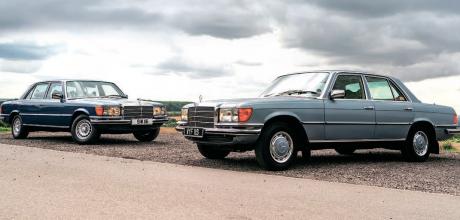1972 Mercedes-Benz 280S W116 vs. 1980 Mercedes-Benz 450SEL Automatic V116
Marking 50 years since the launch of the 116-series S-Class with help from two keen owners. Half a century after their grand debut, the 116-series Mercedes-Benz S-Classes remain highly impressive limousines, combining breathtaking sophistication with self-assured looks and effortless performance – characteristics that are serving them well in today’s collector market.
S is for Special
WORDS RICHARD MASON
IMAGES CRAIG PUSEY
50 YEARS OF W116 FIRST S-CLASSS
“The 116-series S-Class was one of Mercedes’ first ‘world cars’”
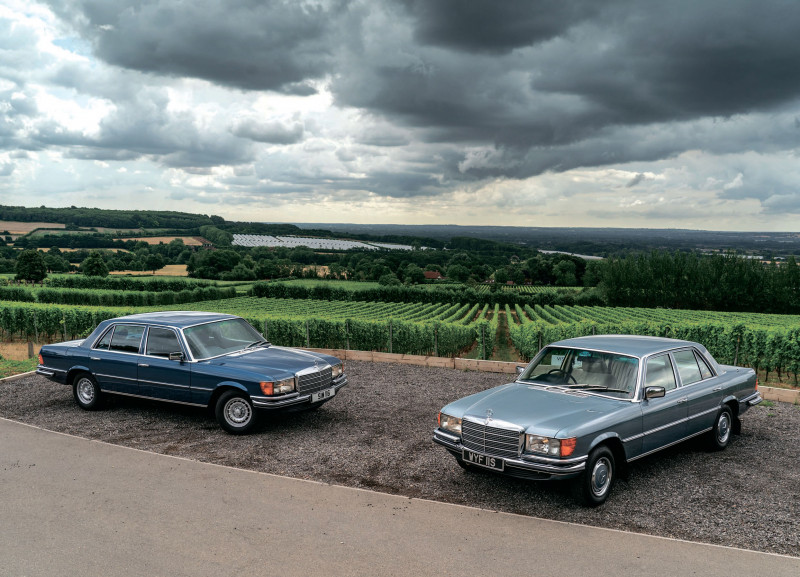
It’s the mid-1960s. Mercedes-Benz is having a reality check, realising the way forward in the prestige market can’t be bigger and bigger cars. Although the recently launched 600 Grosser is selling well to the uber-elite, it’s not the future. A new segment of sophisticated buyers, often backed by corporate car schemes, is emerging in the USA and Europe. They are the future, not dictators and popstars.
To appeal to this audience, Mercedes needs its new flagship model to have kerb presence, be satisfying to drive, extremely comfortable, definitely safe, with a nod to economy, and blend all this into a design that endures. The Sonderklasse – the Special class or S-Class – is born.
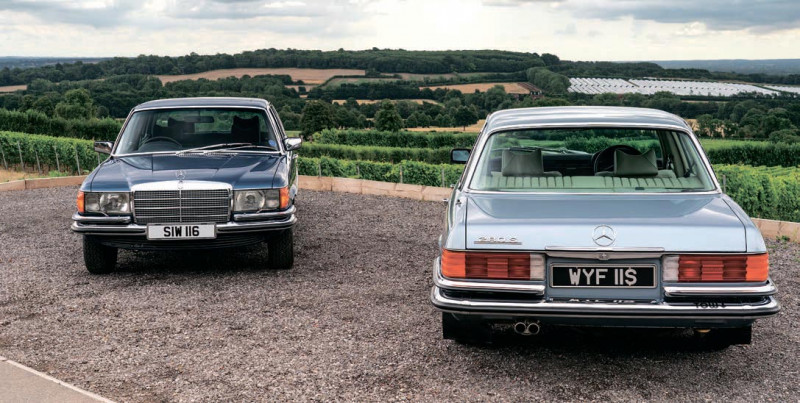
“The 116-series S-Class was both the beginning and the end of an era”
A Mercedes-Benz advert of the time said, “Engine performance alone is still no convincing argument in the luxury class.” Did the manufacturer succeed? Automotive journalists at the 1972 launch thought this first S-Class looked understated, even conservative, although generally agreed performance, handling, comfort, safety and engineering excellence were ahead of the competition. Now celebrating its 50th anniversary, we look back at that first S-Class, the 116-series, with help from owners of a 280S W116 and 450SEL V116.
Providing an overview of this first- generation S-Class is Jamie Gibbs, Mercedes-Benz Club W116 Model Register Captain, and owner of a 450SEL (not the one pictured) plus two 6.9s. “At the time, the USA was becoming an important market for Mercedes. This market had to be central to the company’s thinking because it was setting trends with emission control, safety and fuel economy regulations. “The 116-series was one of Mercedes’ first ‘world cars’ along with the R107 SL, which was actually designed in parallel. Planning started in 1966, a year after the launch of the W108/109.
Friedrich Geiger was head of the styling department and Bruno Sacco was one of his protégés, so it was a strong team. They faced quite a challenge – the W108/109 wasn’t capturing the attention a flagship car should and was known by some as the ‘finless Fintail’. Only the double chrome bumpers were retained from the W108,” Jamie confirms. “Launching in September 1972, just before the fuel crisis, the W/V116 drivetrain had economy in mind, and the standard- and long-wheelbase cars boasted good drag coefficients for their time. Models available were the 280S and 280SE/SEL in-line sixes, and the 350SE/SEL and 450SE/SEL V8s. The 2.8 used the twin-cam engine from the W114. The S entry level was carburettor, which was perfectly acceptable because fuel injection was still regarded as exotic.
“Speaking of which, fuel injection was D-Jetronic, switching to K-Jet in 1975 as K-Jet was significantly cheaper for Bosch to manufacture,” Jamie continues. “The diagnostic equipment was also cheaper for the dealers. The larger V8 450SEL (and 350SEL) arrived in 1973 and captured the ‘Car of the Year’ award the following year. The 6.9 originally due out the same year was held back two years because of the oil crisis.
“In February 1976, a pair of converted 280SE models were used as ‘torch bearers’ for the 1976 Winter Olympics in Innsbruck, Austria. The Olympic flame was carried from Vienna to Innsbruck in a special glass dome mounted on the roof. Two cars were prepared in case one broke down.”
Old flame
Jamie explains, “The 116-series is underpinned by significant technical advancements. For example, to improve comfort and safety double-wishbone front suspension was used to minimise nose diving under heavy braking. The rear suspension evolved from the swing axle of the W108 to a semi trailing arm, giving better handling.” An option (on all but theV116 6.9 model) was hydraulic self-levelling suspension creating even more comfort and refinement.
Safety was high on the agenda and simulations were done on computer for the first time. A unique safety feature was a patented anti-burst door device. Additional strengthening was given to the doors, door pillars and roof frames. Later models also received thicker door cards. The fuel tank was positioned above the rear axle to protect it from rear end impacts. Interiors used soft materials for safety, banishing the traditional hard Bakelite steering wheel.
“The options list was interesting. The 116-series was the last Mercedes-Benz offering either a column- or floor-mounted gear change, be it manual or automatic, except on the 6.9. Apparently, column shifts were popular in the USA. Surprisingly, a second door mirror was an extra as were electric windows – they were only standard on the 6.9. Not surprisingly, air conditioning was a very expensive option. A climate control set up was available in the USA – I think the design was borrowed from Chrysler,” Jamie offers. “In October 1978, the 116-series became the first passenger car in the world offered with anti-lock brakes.
“As classics, the 280 and 450 are the most common because they were the best sellers,” Jamie continues. “The 6.9 also survives in good numbers, although cars are either in first rate condition or need a lot of attention. The number of 116 S-Classes really dropped in the 1980s with the lack of owners’ groups, no internet and the complexities of the fuel injection. With the 116’s tendency to rust from the inside out, their decline was assured. Really, it’s relatively recently that they’ve become collectable across the range, not just 6.9s.
“Not being a big-selling car in the UK, finding parts can be tricky. Interior trim is difficult to repair, especially the velour seats which are turning to dust with age. MB-Tex or leather is durable although very few came with leather; MB-Tex was more popular. The 280s are every bit as drivable as the V8s, so don’t be a badge snob,” Jamie reckons. “The 6.9 is more complex with its hydro-pneumatic suspension, and M100 engine parts are expensive. Now that the 116-series S-Class has solid classic status, enthusiasts can be more confident about buying one.”
1972 Mercedes-Benz 280S W116
Now we meet two owners who did just that, and for surprisingly similar reasons, even though their cars are from opposite ends of the model range. Marcus Warren (pictured on page) was reunited with his dad’s 280S 43 years after it was sold. Marcus’ dad, known as Grove, liked Mercedes and with good reason as he’d driven his family from England to Dubai in a W114. In 1978, Grove treated himself to a new 280S four-speed manual with reinforced rear suspension and a sump guard. Interestingly, the speedometer is in km/h.
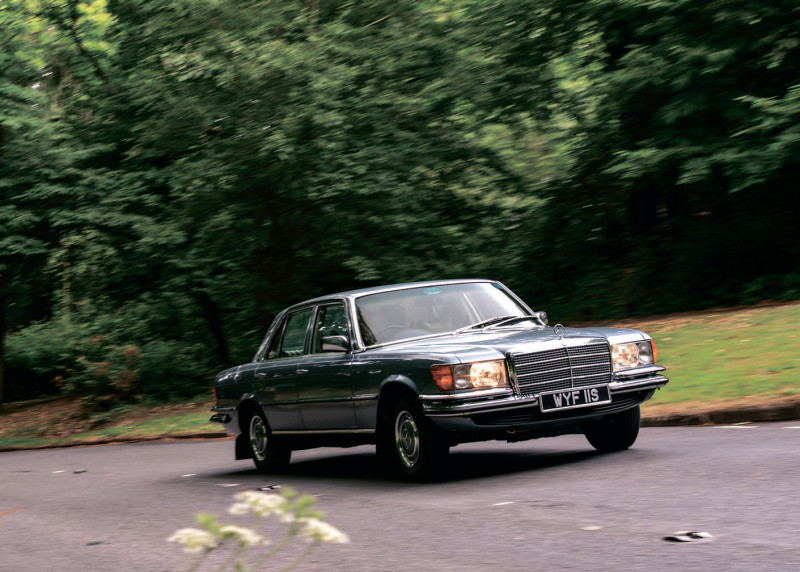
Marcus takes up the story. “Dad took delivery of the 280S in Stuttgart in June 1978 and drove it back to England. Apparently the 280S was never sold in the UK. Dad was a civil engineer and went for a simple specification on the basis that there would be less to go wrong, hence choosing the Solex carburettor version over fuel injection. Maybe the suspension upgrade was to cope with towing his caravan?
As for the sump guard, he possibly had thoughts of another Middle East drive, which might also account for the km/h speedo. “Our family chose the colour, though,” Marcus laughs. “Dad wanted maroon which we thought was horrible, so we persuaded him to order light blue metallic. Looking back, we should have let him have the colour he wanted – the car was his treat.” Grove also went for hard-wearing MB-Tex. As far as Marcus can remember (he was a teenager then) the 280S was reliable and was regularly serviced. “Actually, Dad didn’t do any epic trips in the car and only owned it three or four years before selling it.
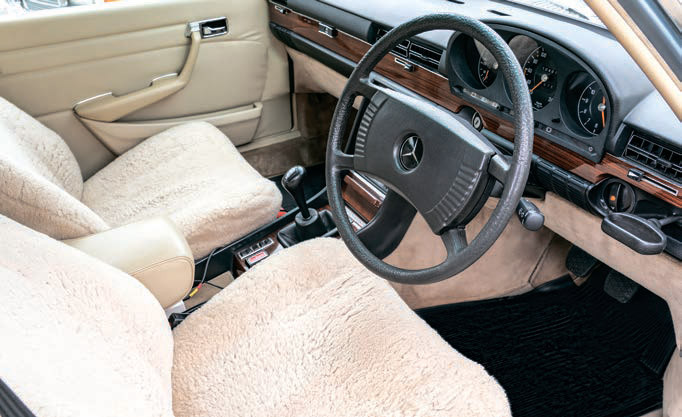
“In early 2021, whilst chatting with my brother Simon about cars, I casually mentioned Dad’s 280S,” Marcus continues. “We found a family photo of Dad with the car which gave us the registration. The DVLA database confirmed the 280S was still going strong but then the question was, ‘How do we find it?’” Marcus didn’t delay the process – he joined The Mercedes-Benz Club and wrote to its publication enclosing a photo of Grove with the 280S. “My brother thought this was a fool’s errand and that I wouldn’t get any response.
“However, in April 2021 a club member got in touch with me having seen the car for sale at a garage in Oxfordshire,” Marcus remembers. “A few days later, Simon and I went to view the car at Rally Preparation Services in Witney. The company was storing it for a client who now wanted to sell it. Both the current and previous owners had rallied the 280S using the services of RPS. The then current owner did the Baltic Rally, and the earlier owner did Le Jog twice.”
Despite these endeavours, Marcus reports that rallying hasn’t damaged the car. A tripmeter discreetly sited in the glovebox and the ‘Tow’ labels front and rear are the only clues to its competition history. Marcus and Simon weren’t quite sure how they’d react when they saw the 280S after 43 years. “We were very emotional when we saw it, although we didn’t disclose our link because we didn’t want to compromise our negotiation position,” says Marcus. “RPS thought it was a South African import although the service book showed the car was serviced in Surrey. However, once the deal was concluded the owner was overjoyed that the Mercedes was being reunited with our family. On the test drive, I kept thinking of Dad driving it.”
Technically, Marcus is the owner, paying £16,500 to secure the 280S. “RPS agreed to fix some slight rust on the front passenger door and to restore the bonnet to its original colour. The car had only covered about 64,000 miles and was in immaculate condition.” Marcus collected the 280S a few days later, in May 2021, and it’s now in a storage facility. “I’ve only put about a thousand miles on the clock,” he confirms. “I’ve done the London to Brighton Classic run and attended two car shows. I take it out when the weather is nice. I have another classic, a C124 E320, that’s my daily driver. “My greatest wish would be to trace all the former owners. So far, I’ve only been in touch with two. Before I bought it, there were seven owners. Of course, one is Dad so there are four left to trace. So if anyone recognises it please contact me.”
1980 Mercedes-Benz 450SEL Automatic V116
Danny Lucas bought his 1979 450SEL in spring 2020. “I spotted the car at the facility where I store some of my cars,” he begins. “I think it’d been there since 2016. The colour jumped out at me – Magnetite Blue metallic. Very unusual. With permission, I pulled off the cover to see it better and it was an amazing example. All original since 1979 with 50,000 miles plus all the history. The original owner was John Lumley-Robinson, the son of the inventor of the Jubilee Clip, and I guess it was his company car.”

The 450SEL wasn’t for sale at the time, but Danny had a unique sales pitch. He’s created a private Mercedes-Benz museum (see the June/ July 2021 issue) and is always looking for suitable cars to display. “The storage business contacted the car’s owner who lived in Spain. Luckily for me, he was delighted to know that if he sold the car to me, it would be on display and not just hidden away as it was then.
“We were easily able to agree a price and a deal was done. Nothing needed doing at all – it’s like a showroom car,” says Danny. “Driving the 450SEL and then comparing it to a W109 I have is fascinating. Stepping out of the W109 and getting into its successor took me back to the 116’s launch day. What a progression in so many ways. Even now, it feels new-car-tight to drive – the steering’s precise, the brakes are sharp, all the control stalks work and feel like new, there’s no speedo wobble. I was once caught out by torrential rain on single track roads, but the SEL was so sure-footed and easy to drive.”
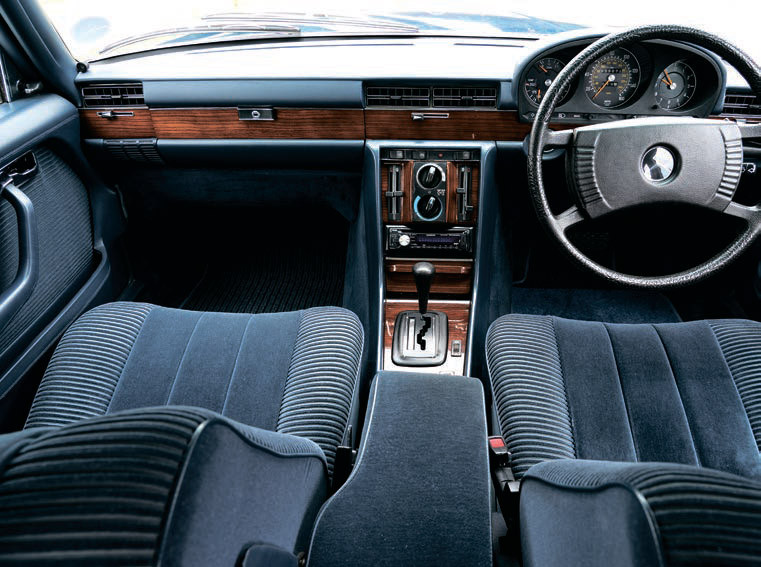
“The steering’s precise, the brakes are sharp, all the control stalks work and feel like new”
Danny’s been in awe of the Mercedes-Benz brand since he was six years old. Luckily for him, his father was an enthusiastic Mercedes customer and of course had a W116. “He bought a used 350SE in Icon Gold in 1978. I remember my first ride in it going to Luton Airport as an 11-year old. Sitting in the back felt like the best place on earth. The car got lots of attention and I thought this is just the ultimate. So when I saw this 450SEL, all those memories and feelings came flooding back. The prominence and presence of the double chrome bumpers, the headlights, those ribbed tail lights, quintessentially Mercedes – it’s just the daddy of the range.
Times of change
“This 450SEL has velour upholstery with ribbed sides to the seats and the uniformity of a well mown lawn,” Danny adds. “It’s a nice alternative to leather. In Germany they call it the ‘Pullman interior’. The colour combination is magnificent.”
Looking back, the 116-series S-Class in all its forms was both the beginning and the end of an era. As stylish as those twin chrome bumpers are, they couldn’t make it in the shoulder pad-clad 1980s – an era when bumpers were disappearing, blending into the overall body shape and made of plastic and aluminium to save weight. The fluted rear lights adopted on the 126-series successor are the only testimony to its ancestry. Mind you, the venerable 2.8-litre engine made it to the first generation 126. Meanwhile, the Q-car concept died with the 6.9, only to be revived in some style by the ingenious engineers at AMG.
Perhaps the final judgement is in the sales figures. Mercedes-Benz sold 473,035 of the 116-series in nine years whereas its successor sold 818,036 times over in 12 years. The 116 lives on in celluloid in For Your Eyes Only when Roger Moore pushes both car and villain off a cliff with one foot. And who can forget the Milan Brown 6.9 in Ronin?
Leaving all that aside, as Model Register Captain Jamie says, “The 116-series was the pioneer which set the standards and defined the values that decades of Mercedes-Benz S-Class follow to this day.”
Just the facts
TECHNICAL DATA Mercedes-Benz 280S (W116)
- ENGINE M110 2,746cc 6-cyl
- Max POWER 154bhp @ 5,500rpm
- Max TORQUE 164lb ft @ 4,000rpm
- TRANSMISSION 4-speed manual, RWD
- WEIGHT 1,610kg
- 0-62MPH 11.5sec
- TOP SPEED 118mph
- FUEL CONSUMPTION 22.6mpg
- YEARS PRODUCED 1972-1980
TECHNICAL DATA Mercedes-Benz 450SEL (V116)
- ENGINE M117 4,520cc V8
- MAX POWER 222bhp @ 5,000rpm
- MAX TORQUE 271lb ft @ 3,250rpm
- TRANSMISSION 3-speed auto, RWD
- WEIGHT 1,765kg
- 0-62MPH 9.9sec
- TOP SPEED 130mph
- FUEL CONSUMPTION 19.5mpg
- YEARS PRODUCED 1973-1980
All figures from Mercedes-Benz for a 1978 280S and 1979 450SEL as pictured; fuel consumption determined at 3/4 of top speed (not more than 110km/h, 68mph) plus 10 per cent
Thank you to Yotes Court Vineyard in Kent for the photoshoot location Web yotescourt.co.uk
116 S-Class designer Friedrich Geiger also penned the Gullwing.
velour trim and glossy wood lifts the conservative cabin.
Mercedes built 59.5K 450SELs and 41.6K 450SEs. The spacious cabin is a delight for the senses. M117 V8 with Bosch K-Jetronic fuel injection.
Danny Lucas has owned his limo since 2020.
450SEL V8 still has plenty of life left in it yet…
“In February 1976, a pair of converted 280SE models were used as ‘torch bearers’ for the 1976 Winter Olympics”
280S offered with 4- and 5-speed manuals, plus a 4-speed automatic.
Marcus' dad owned this 280S previously…
Straight-six (M110) also used in the 123 cars.
Would you believe this 280S has been rallied?! Seat covers preserve the MB-Tex beneath. SE cars are 4,960mm long, SELs 5,060mm. Has anyone sat here before? We think not!
“A tripmeter discreetly sited in the glovebox and the ‘Tow’ labels are the only clues to its competition history”
“The 116-series S-Class was one of Mercedes’ first ‘world cars’”


